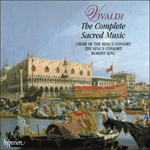
Welcome to Hyperion Records, an independent British classical label devoted to presenting high-quality recordings of music of all styles and from all periods from the twelfth century to the twenty-first.
Hyperion offers both CDs, and downloads in a number of formats. The site is also available in several languages.
Please use the dropdown buttons to set your preferred options, or use the checkbox to accept the defaults.

RV604 belongs to the group of psalms Vivaldi wrote for Easter Sunday at the Pietà in 1739. It survives not only in Turin but also in the fragments of the Pietà’s repertory today preserved at the Conservatorio di Musica ‘Benedetto Marcello’ in Venice. It is amusing to see, from the parts copied out for their own use by the Pietà’s musicians, that they had just as much difficulty as we sometimes have today in deciphering Vivaldi’s intentions.
The composer does his best to keep the musical interest alive in this 97-bar movement. He varies the accompanimental patterns on the violins, changes key in effective and sometimes surprising ways, and utilizes different kinds of vocal texture (albeit without ever foregoing a pervasive homophony). Imitating the structure of the Psalm’s verses, he sometimes adopts a responsorial style in which the solo sopranos alone are answered by the full choir. Word-painting is rarely encountered. Because of its deliberate simplicity, this setting shows few differences from the comparable pieno settings from the ‘first’ period, RV606 and 607, which were composed over twenty years earlier.
from notes by ©
RV604, qui appartient à un ensemble de psaumes composé pour le dimanche pascal, à la Pietà, en 1739, survit non seulement à Turin, mais dans les fragments du répertoire de la Pietà actuellement conservés au Conservatorio di Musica «Benedetto Marcello», à Venise. Chose amusante, les parties que les musiciens de la Pietà copièrent pour leur propre usage révèlent qu’ils avaient parfois autant de difficultés que nous à déchiffrer les intentions de Vivaldi.
Le compositeur fait de son mieux pour maintenir vivante la dynamique musicale de ce mouvement de quatre-vingt-dix-sept mesures. Il varie les modèles d’accompagnement aux violons, change de tonalité de manières efficaces, voire surprenantes, et recourt à différents types de texture vocale (sans jamais, toutefois, renoncer à l’omniprésente homophonie). Imitant la structure des versets psalmiques, il adopte de temps à autre un style responsorial, où le chœur entier répond aux seuls sopranos solo. De par sa simplicité délibérée, cette pièce, aux madrigalismes rares, ne diffère guère des mises en musique pieno de la «première» période, RV606 et 607, composées plus de vingt ans auparavant.
extrait des notes rédigées par Michael Talbot © 2000
Français: Hyperion Records Ltd
RV604 gehört zu der Gruppe von Psalmen, die Vivaldi für den Ostersonntag 1739 in der Pietà verfaßte. Er blieb nicht nur in Turin erhalten, sondern auch in jenen Fragmenten des Repertoires der Pietà, die heute im Conservatorio di Musica „Benedetto Marcello“ in Venedig aufbewahrt werden. Es ist amüsant festzustellen, daß die Musiker der Pietà bei den zum eigenen Gebrauch kopierten Stimmen genauso große Schwierigkeiten hatten, die Absichten Vivaldis zu entziffern, wie wir sie heute manchmal haben.
Der Komponist tut sein Bestes, um in diesem 97 Takte langen Satz das musikalische Interesse wachzuhalten. Er variiert die Geigenbegleitung, wechselt die Tonart auf wirkungsvolle und manchmal überraschende Weise und nutzt unterschiedliche Vokalstrukturen (auch wenn er niemals auf die bestimmende homophone Satztechnik verzichtet). Indem er die Struktur der Psalmen imitiert, bedient er sich gelegentlich eines responsorialen Stils, in dem der gesamte Chor den Sopransolisten antwortet. Tonmalerei kommt kaum vor. Auf Grund ihrer gewollten Schlichtheit weist diese Vertonung nur wenige Unterschiede zu den vergleichbaren pieno-Vertonungen RV606 und 607 aus seiner ‘ersten’ Schaffensperiode auf, die über zwanzig Jahre früher entstanden.
aus dem Begleittext von Michael Talbot © 2000
Deutsch: Anne Steeb/Bernd Müller
 Vivaldi: The Complete Sacred Music Vivaldi: The Complete Sacred Music‘For King's sterling service to the Vivaldian cause, one of his most important recording and satisfying projects to date, I am thankful’ (Gramophone) ‘If you're waiting for the perfect collection of Vivaldi's sacred music, this is it. It was a happy day when this beautiful boxed set arrived in my m ...» More |

